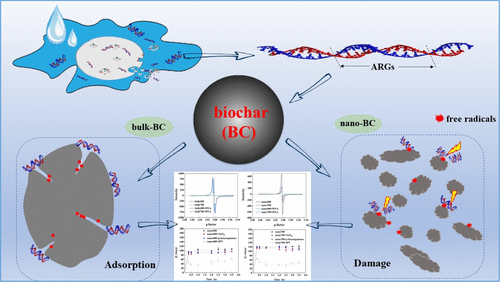当前位置:
X-MOL 学术
›
Environ. Sci. Technol.
›
论文详情
Our official English website, www.x-mol.net, welcomes your feedback! (Note: you will need to create a separate account there.)
Size Matters: Nano-Biochar Triggers Decomposition and Transformation Inhibition of Antibiotic Resistance Genes in Aqueous Environments.
Environmental Science & Technology ( IF 11.4 ) Pub Date : 2020-06-19 , DOI: 10.1021/acs.est.0c02227 Fei Lian 1, 2 , Wenchao Yu 2, 3 , Qixing Zhou 3 , Shiguo Gu 1 , Zhenyu Wang 1 , Baoshan Xing 2
Environmental Science & Technology ( IF 11.4 ) Pub Date : 2020-06-19 , DOI: 10.1021/acs.est.0c02227 Fei Lian 1, 2 , Wenchao Yu 2, 3 , Qixing Zhou 3 , Shiguo Gu 1 , Zhenyu Wang 1 , Baoshan Xing 2
Affiliation

|
Antibiotic resistance genes (ARGs) are considered to be a type of emerging contaminant; their interaction with biochar (BC) could affect their dissemination and fate in the environment. Although adsorption of ARGs onto bulk-BC has been reported, the interaction with nanosized BC (nano-BC) is largely unknown. In this study, the interactions of a model extracellular DNA (eDNA, calf thymus DNA) and two typical ARGs (ampC and ermB) extracted from a natural river with bulk- and nano-BCs from two pyrolysis temperatures (400 and 700 °C) were investigated. Only adsorption was observed on bulk-BCs, while not only adsorption but also fragmentation of these eDNA molecules was found to occur on nano-BCs. Also, their replication was greatly inhibited by nano-BCs. The electron paramagnetic resonance results indicated that hydroxyl radicals produced from persistent free radicals (PFRs) on nano-BCs played a major role in the damage of eDNA. Moreover, the direct contact with nonradical reacting sites and PFRs on nano-BCs also contributed to the decay of eDNA. Comparatively, PFRs in bulk-BCs were difficult to be reached by eDNA because of steric hindrance and played a negligible role in destroying eDNA. These findings highlight the importance of the size effect in evaluating the reactivity and related environmental risks of PFRs on BC and improve our understanding on the interaction between ARGs and BC.
中文翻译:

大小事项:纳米生物炭引发水环境中抗生素抗性基因的分解和转化抑制。
抗生素抗性基因(ARGs)被认为是一种新兴的污染物。它们与生物炭(BC)的相互作用可能会影响其在环境中的传播和命运。尽管已经报道了ARGs吸附在块状BC上,但与纳米级BC(nano-BC)的相互作用尚不清楚。在这项研究中,模型细胞外DNA(eDNA,小牛胸腺DNA)和两个典型ARG(amp C和erm)的相互作用B)研究了从两种热解温度(400和700°C)中从具有大体积BC和纳米BC的天然河流中提取的物质。在散装BC上仅观察到吸附,而在纳米BC上不仅发现了这些eDNA分子的吸附而且发生了断裂。而且,它们的复制受到纳米BC的极大抑制。电子顺磁共振结果表明,纳米BCs上的持久性自由基(PFR)产生的羟基自由基在eDNA的损伤中起主要作用。而且,与非自由基反应位点和纳米BCs上的PFR的直接接触也有助于eDNA的降解。相比之下,由于空间位阻,eDNA很难达到散装BC中的PFR,并且在破坏eDNA中的作用可忽略不计。
更新日期:2020-07-21
中文翻译:

大小事项:纳米生物炭引发水环境中抗生素抗性基因的分解和转化抑制。
抗生素抗性基因(ARGs)被认为是一种新兴的污染物。它们与生物炭(BC)的相互作用可能会影响其在环境中的传播和命运。尽管已经报道了ARGs吸附在块状BC上,但与纳米级BC(nano-BC)的相互作用尚不清楚。在这项研究中,模型细胞外DNA(eDNA,小牛胸腺DNA)和两个典型ARG(amp C和erm)的相互作用B)研究了从两种热解温度(400和700°C)中从具有大体积BC和纳米BC的天然河流中提取的物质。在散装BC上仅观察到吸附,而在纳米BC上不仅发现了这些eDNA分子的吸附而且发生了断裂。而且,它们的复制受到纳米BC的极大抑制。电子顺磁共振结果表明,纳米BCs上的持久性自由基(PFR)产生的羟基自由基在eDNA的损伤中起主要作用。而且,与非自由基反应位点和纳米BCs上的PFR的直接接触也有助于eDNA的降解。相比之下,由于空间位阻,eDNA很难达到散装BC中的PFR,并且在破坏eDNA中的作用可忽略不计。



























 京公网安备 11010802027423号
京公网安备 11010802027423号